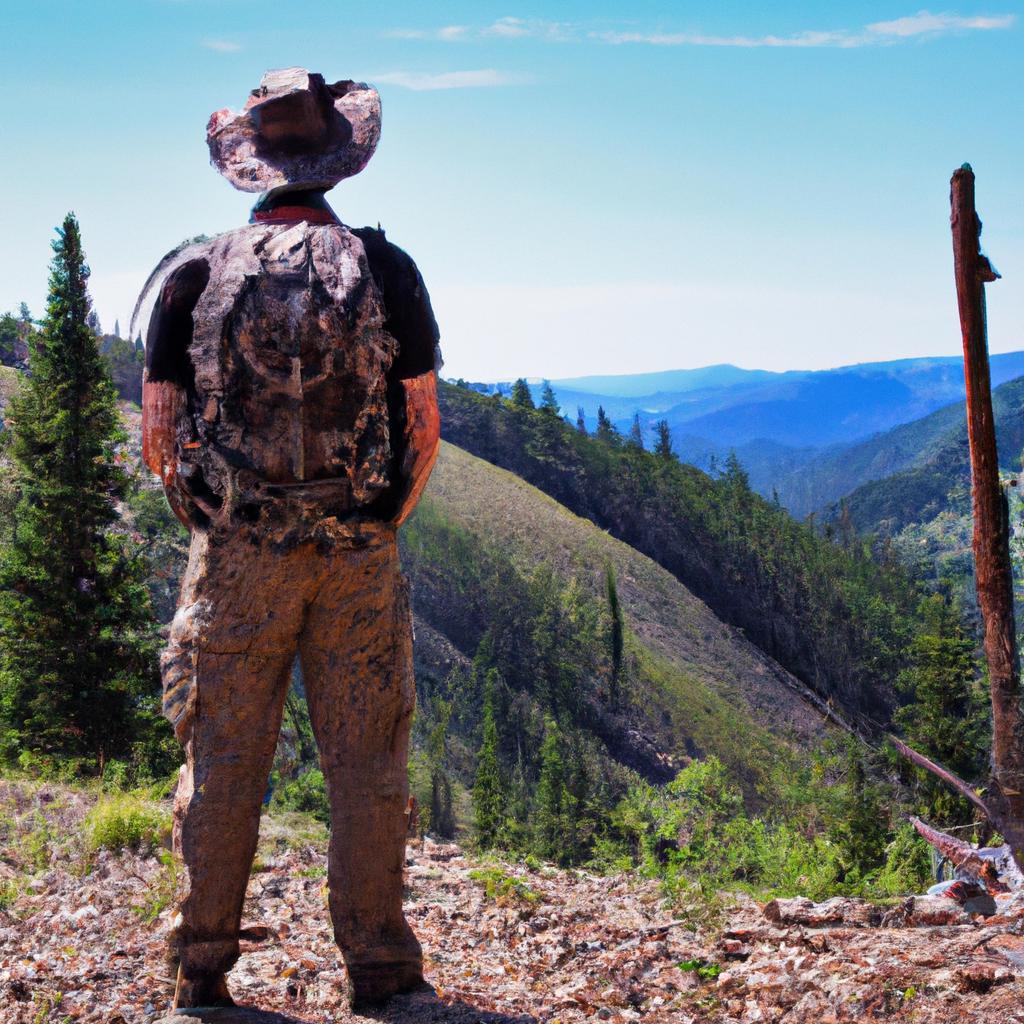If you’re an avid nature lover and a fan of Jon Krakauer’s captivating book “Into the Wild,” chances are you’ve heard of the Stampede Trail. Situated in the heart of Alaska, this 45-mile-long trail has become famous due to the tragic story of Christopher McCandless, who ventured into the wild in 1992 seeking adventure and meaning. However, the Stampede Trail is far more than just a somber location; it is a remarkable piece of history and a breathtaking landscape that offers both challenges and rewards for intrepid hikers and explorers.
A Journey Through Time
The Stampede Trail boasts a long and fascinating history that dates back to the early 1900s. Originally, it served as a mining road constructed by the Alaska Engineering Commission to grant access to the gold mines nestled within the Kantishna Hills. Named after the prosperous Stampede Mine, once one of the region’s most successful gold mines, the trail witnessed an era of bustling activity.
Following the gold rush, the trail served various purposes, including the transportation of coal and supplies, and served as a recreational haven for hunting and fishing. In the 1960s, the trail was upgraded to a gravel road to accommodate vehicles. However, due to its exposure to harsh weather conditions and a lack of maintenance, the road gradually deteriorated and was ultimately closed to public use in the 1990s.
Today, the Stampede Trail attracts primarily hikers and backpackers yearning for challenging and rewarding outdoor experiences. The remnants of abandoned cabins, mines, and other relics scattered across the landscape serve as poignant reminders of the human history intertwined with this rugged terrain.
Into the Wild: McCandless’s Journey
Krakauer’s book “Into the Wild” tells the awe-inspiring yet tragic tale of Christopher McCandless, a young man who embarks on a profound quest for solitude and simplicity in the Alaskan wilderness. McCandless, in search of self-discovery, eschews his comfortable life after graduating from college and ventures into the unforgiving wilderness. Alas, his journey concludes tragically as he perishes from starvation in an abandoned bus located on the Stampede Trail.
The Stampede Trail plays a central role in McCandless’s narrative, serving as the conduit leading to his final destination. Krakauer poignantly describes the trail’s unforgiving terrain, its picturesque scenery, and the formidable challenges it presents, such as treacherous river crossings and perilous wildlife encounters. The trail becomes a metaphor for McCandless’s unyielding pursuit of freedom and self-realization as he leaves civilization behind and immerses himself in a world defined by untamed nature and uncertainty.
While the book and McCandless’s story have ignited controversy and debate, with some appreciating his courage and idealism and others criticizing his recklessness and naivety, it serves as a cautionary tale. It underscores the significance of preparedness, knowledge, and respect for nature in the face of wilderness survival.
Embarking on the Stampede Trail
Embarking on a trek along the Stampede Trail requires fortitude and resilience. The trail is demanding and remote, devoid of cell phone coverage, easy access to supplies, or immediate medical assistance. Hikers encounter steep hills, dense vegetation, and perilous river crossings that become even more challenging or impassable depending on the season. Furthermore, unpredictable weather conditions, including snow, rain, and powerful winds, heighten the hike’s difficulty.
To hike the Stampede Trail, one must obtain a permit from the Alaska Department of Natural Resources. The permit, provided free of charge, necessitates a comprehensive submission of trip details, emergency contacts, and information regarding one’s experience and equipment. This permit system empowers authorities to monitor hikers and mitigate potential accidents or emergencies.
If you aspire to traverse the Stampede Trail, meticulous preparation and the right gear and supplies are paramount. Here are some valuable tips for a successful expedition:
- Thoroughly research the trail and the area, acquainting yourself with its risks and challenges.
- Pack sufficient food and water for the entirety of your journey, including water purification methods for replenishing your supplies.
- Equip yourself with appropriate clothing and footwear, encompassing rain gear, warm layers, and sturdy boots.
- Carry a map, compass, and GPS device, ensuring you possess the necessary skills to operate them effectively.
- Exercise caution and be knowledgeable about wildlife encounters, particularly encounters with bears and moose; adhere to safety guidelines.
- Leave no trace of your presence, respecting the environment and other hikers sharing the trail.
Navigating the Risks and Dangers
While the Stampede Trail offers a unique and exhilarating hiking experience, it simultaneously presents several hazards and risks that hikers should be aware of. Here are some of the most significant challenges one might encounter:
Wildlife Encounters
The Stampede Trail serves as a habitat for a diverse array of wildlife, including bears, moose, wolves, and coyotes. While these creatures are mesmerizing from a distance, they pose a threat if one comes too close. Carrying bear spray and mastering its usage, as well as properly securing food and trash to prevent attracting animals to your campsite, are essential precautions.
Weather Conditions
Alaska’s weather is renowned for its capriciousness, with rapid changes occurring even during the summer months. Hikers on the Stampede Trail must be prepared for rain, snow, wind, and sun, necessitating appropriate attire and gear. The trail can become muddy and slippery in wet conditions, intensifying navigation challenges.
Navigation Challenges
The Stampede Trail lacks clear markers, requiring hikers to possess competent navigation skills and equipment, including a compass and map. Some sections of the trail may be overgrown, and river crossings can be particularly daunting, especially when water levels are high. Thorough research and meticulous planning of your route are crucial before embarking on the hike.
Preserving the Stampede Trail
As the Stampede Trail’s popularity surges and more individuals seek to embark on its trails, preserving this fragile environment for future generations becomes paramount. Here are some of the initiatives undertaken by individuals and organizations to protect this cherished trail:
Efforts to Preserve the Trail
Under the management of the State of Alaska, the Stampede Trail falls within Denali State Park. Park rangers play a critical role in maintaining the trail, ensuring its safety and accessibility for hikers. However, due to the trail’s remote location and limited resources, much of the maintenance work is entrusted to volunteers and nonprofit organizations.
Responsible Hiking and Leave No Trace
Preserving the Stampede Trail hinges on practicing responsible hiking and adhering to the principles of Leave No Trace. This entails minimizing your impact on the environment by staying on designated paths, removing all traces of your presence, and using stoves instead of building fires. Respect for wildlife and consideration for fellow hikers, ensuring a safe distance and a harmonious coexistence, form the bedrock of responsible hiking.
Deliberating the Trail’s Future
The future of the Stampede Trail remains uncertain as its popularity continues to soar. While promoting responsible hiking and preserving the trail’s natural splendor undoubtedly remain crucial, managing its usage and limiting its impact on the environment stands paramount. The State of Alaska is actively developing a long-term management plan for Denali State Park, encompassing the Stampede Trail. This plan will address issues such as trail maintenance, visitor education, and the conservation of resources. Through collaborative efforts, we can safeguard the Stampede Trail’s allure as an inspiring destination for years to come.
To learn more about outdoor adventures and explore a wide range of quality equipment, visit TooLacks. Embark on your own journey into the wild and uncover the beauty and challenges that nature has in store for you.



